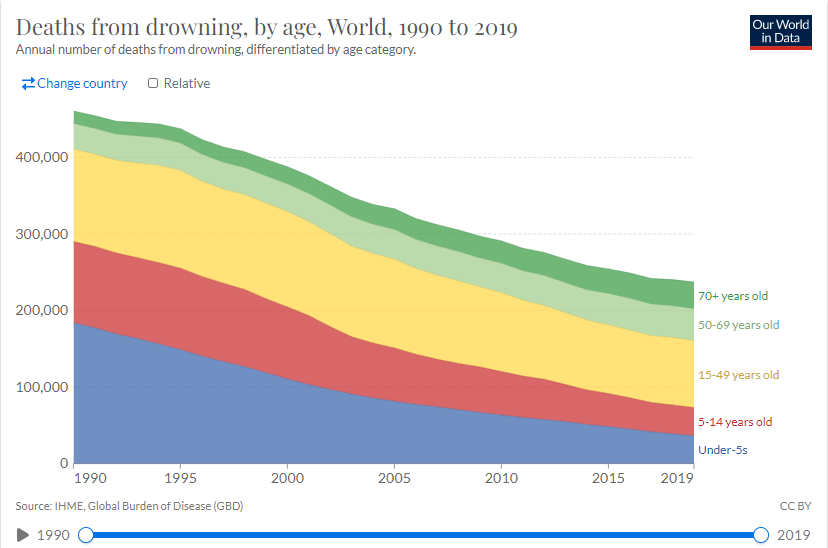
Swimming is popular around the world, but where is it the most popular? Have you ever wondered why swimming is popular in some countries and not others? What does swim education mean? When we take a look at the swimming world abroad, you’ll see a connection between the wealth of a nation and drowning statistics. What does this mean and why is it significant?
In the Swimming World: Do You Know What Swimming is Like Abroad?
World Drowning Statistics
There were 237,242 drowning deaths globally in 2019, an approximate total cited by the World Health Organization. Drowning is among the top ten leading causes of death globally, especially amongst men and children.
According to the CDC, more children ages 1-4 die from drowning than any other cause besides birth defects. Additionally, more than 40% of drowning treated in emergency departments require hospitalization or further medical treatment.
Check out the chart below to learn about how drowning measures up to other causes of death.
This global look at drowning deaths shows that 36,507 of the 237,242 were children under age five. 36,657 were children aged 5-14 years old. While 87,541 were between the ages of 15-49, 41,492 were between the ages of 50-69 years old and 35,044 were 70+ years old. In other words, 30.8% of drowning deaths were children.
Fortunately, this graph shows a noticeable improvement over the past three decades. However, drowning deaths among youth remain at an all-time high, despite it being a preventable accident. We have this data, but the true scope of the issue remains a mystery, due to poor data collection systems about drowning deaths across the world. The WHO estimates that the annual amounts of deaths attributed to drowning could be four to five times more than the current estimate.
What Role does Social Economics Play?
Of the 237,242 global drowning deaths, 90% occur in lower-mid income countries. For example, in China and Bangladesh, the leading cause of death among children aged 5-14 years old is drowning, which accounts for 30.8% of drowning deaths across the world. These statistics demonstrate the impact of this problem on such countries; a lack of accessibility and education play a significant role here.
Drowning deaths in high-income countries are slowly declining. Such reductions come from the provision of clean drinking water, less exposure to open water, better literacy and economic development. Safe standards, policies and legislation also contribute to lower rates of drowning.
Here’s an interactive graph that changes over time. It visually represents the relationship between drowning death rates and wealth. As the wealth of a nation rises, its drowning rates decline and vice versa. More developed nations are better equipped to introduce fundamental facilities and systems such as education programs.
Why are People in Low-Mid Income Countries More at Risk?
Systematic factors contribute to people in lower-income countries having a higher risk of drowning. The lack of barriers comes to mind. Infants and young children are not always supervised and have poor swim skills. That’s due to low awareness of water dangers increasing their risk of drowning. Additionally, poorer communities have less water transportation, unsafe water supply and flood disasters.
Drowning often affects the poorest and least-educated people living in rural settings. Such communities lack the resources to safely adapt to risks around them.
People in low and middle-income countries living around water interact differently from those in high-income countries. The level of economic and social development makes water exposure riskier.
Children under five are more likely to drown inland and near home. Bathtubs, buckets, ditches ponds and other bodies of water pose a drowning risk that most families aren’t aware of. Older children and adults are more likely to drown in natural bodies of water while working, traveling or collecting water.
Global Drowning Prevention: Accessibility and Education
Since the 20th century ended, we’ve experienced a transition. Communicable and infectious diseases were previously the leading causes of death. The causes have shifted to non-communicable diseases such as heart disease, cancers, diabetes and respiratory disease.
According to data, the trend remains true for developing countries. Unlike non-communicable diseases, accidental deaths are easier to prevent. Drowning prevention isn’t about science; it’s about education.
Teaching survival swimming, resuscitation skills, supervision (of children and adults alike), removing or covering water hazards, targeted prevention strategies and improved community infrastructure (i.e. water supply bridges, levees, etc.) and public awareness prevents drowning.
Additionally, countries should establish effective policies and legislation. Setting and enforcing safe boating, shipping and ferry regulations are essential when it comes to promoting water safety and preventing drowning. Building resilience to flooding and managing flood risk through better disaster preparedness planning, land use planning and early warning systems can prevent drowning during flood disasters.
National strategies for water safety are crucial; they provide water safety awareness. Additionally, smaller nations with lower income brackets can take steps to improve data collection on drowning mortality and morbidity. Drowning is preventable when people are equipped with knowledge. In the swimming world, we’d like to educate people around the world about drowning prevention.
What Can I Do?
Educate yourself and your family about the importance of water safety drowning prevention! Here are some helpful international drowning prevention resources.
Donate to The Drowning Prevention Charity by Royal Life Saving Society UK. Help their efforts to reduce drowning by donating to their international projects.
Register for the World Conference on Drowning Prevention, which takes place in 2023 in Colombo, Sir Lanka.
You can also get involved with National Drowning Prevention Alliance. You become an international NDPA member, an organizational partner or part of their local task force.
Become a member, donate or find out how you can support the International Life Saving Federation.
Donate to the Global Drowning Fund by Royal Life Saving Australia.





